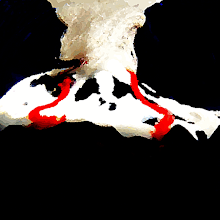
 I found and photographed these on my morning walk through the Windom Conservation Center. The first photograph is a dead skeleton still standing on its foot. There are no twigs on it with buds that promise spring growth. Even in Winter it is easy to tell a dead Cottonwood from a living one.
I found and photographed these on my morning walk through the Windom Conservation Center. The first photograph is a dead skeleton still standing on its foot. There are no twigs on it with buds that promise spring growth. Even in Winter it is easy to tell a dead Cottonwood from a living one.The bottom picture is a fallen dead Cottonwood that had to be cut so that it would not obstruct the walkway. I counted only 43 growth rings on it. Why was the lives of these two similar sized trees cut so short, yet I have a giant in my backyard about 200 years old?
It all relates to competition and opportunistic disease. This nature trail is full of Cottonwood. The cottonwood loves its feet to be wet. These dead ones sit up high on a built up bank. Also white spruce have been planted around by people that maintain the trail. Perhaps they died because the soil was disturbed.
Cottonwood groves start out dense along a water course, then thin out as other kinds of trees move in, until there are only a few very old venerable specimens left. If the mixed forest is washed away in a flood or chewed down by beavers, then the cottonwood cycle repeats itself. Cottonwoods are pioneer trees that start the riparian woodlands.


No comments:
Post a Comment